#PopSci.Com
Explore tagged Tumblr posts
Text
15 Riveting Images From The 2025 UN World Oceans Day Photo Competition
'The Ocean Is The Source of All Life And That Everything In Nature Is Deeply Connected.'
— By Popular Science Team | June 14, 2025
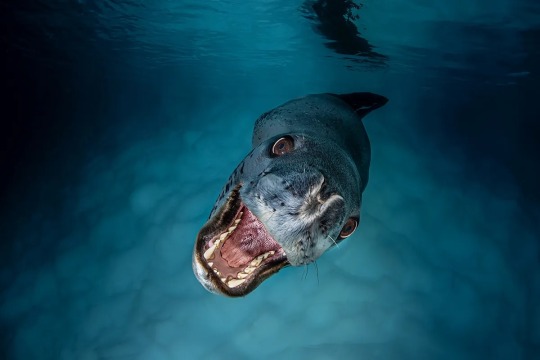
Big And Small Underwater Faces — 3rd Place! Trips To The Antarctic Peninsula Always Yield Amazing Encounters With Leopard Seals (Hydrurga Leptonyx. Boldly Approaching Me And Baring His Teeth, This Individual Was Keen To Point Out That This Part Of Antarctica Was His Territory. This Picture Was Shot At Dusk, Resulting In The Rather Moody Atmosphere. Credit: Lars Von Ritter Zahony, Germany 🇩🇪, World Ocean’s Day
The striking eye of a humpback whale named Sweet Girl peers at the camera. Just four days later, she would be dead, hit by a speeding boat and one of the 20,000 whales killed by ship strikes each year. Photographer Rachel Moore’s captivating image (seen below) of Sweet Girl earned top honors at the 2025 United Nations World Oceans Day Photo Competition.

Top: Wonder: Sustaining What Sustains Us — Winner! This photo, taken in Mo’orea, French Polynesia in 2024, captures the eye of a humpback whale named Sweet Girl, just days before her tragic death. Four days after I captured this intimate moment, she was struck and killed by a fast-moving ship. Her death serves as a heartbreaking reminder of the 20,000 whales lost to ship strikes every year. We are using her story to advocate for stronger protections, petitioning for stricter speed laws around Tahiti and Mo’orea during whale season. I hope Sweet Girl’s legacy will spark real change to protect these incredible animals and prevent further senseless loss. Credit: Rachel Moore (USA 🇺🇸)
Bottom: Underwater Seascapes — Honorable Mention! With only orcas as their natural predators, leopard seals are Antarctica’s most versatile hunters, preying on everything from fish and cephalopods to penguins and other seals. Gentoo penguins are a favored menu item, and leopard seals can be observed patrolling the waters around their colonies. For this shot, I used a split image to capture both worlds: the gentoo penguin colony in the background with the leopard seal on the hunt in the foreground. Credit: Lars von Ritter Zahony (Germany 🇩🇪)
Now in its twelfth year, the competition coordinated in collaboration between the UN Division for Ocean Affairs and the Law of the Sea, DivePhotoGuide (DPG), Oceanic Global, and the Intergovernmental Oceanographic Commission of UNESCO. Each year, thousands of underwater photographers submit images that judges award prizes for across four categories: Big and Small Underwater Faces, Underwater Seascapes, Above Water Seascapes, and Wonder: Sustaining What Sustains Us.
This year’s winning images include a curious leopard seal, a swarm of jellyfish, and a very grumpy looking Japanese warbonnet. Given our oceans’ perilous state, all competition participants were required to sign a charter of 14 commitments regarding ethics in photography.

Top: Above Water Seascapes – Winner! A serene lake cradled by arid dunes, where a gentle stream breathes life into the heart of Mother Earth’s creation: Captured from an airplane, this image reveals the powerful contrasts and hidden beauty where land and ocean meet, reminding us that the ocean is the source of all life and that everything in nature is deeply connected. The location is a remote stretch of coastline near Shark Bay, Western Australia. Credit: Leander Nardin (Austria 🇦🇹)
Bottom: Above Water Seascapes — 3rd Place! Paradise Harbour is one of the most beautiful places on the Antarctic Peninsula. When I visited, the sea was extremely calm, and I was lucky enough to witness a wonderfully clear reflection of the Suárez Glacier (aka Petzval Glacier) in the water. The only problem was the waves created by our speedboat, and the only way to capture the perfect reflection was to lie on the bottom of the boat while it moved towards the glacier. Credit: Andrey Nosik (Russia 🇷🇺)
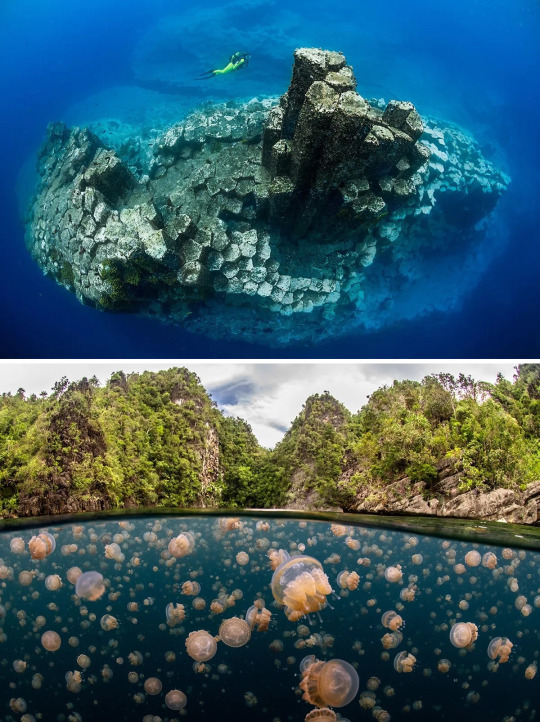
Top: Underwater Seascapes — 3rd Place! “La Rapadura” is a natural hidden treasure on the northern coast of Tenerife, in the Spanish territory of the Canary Islands. Only discovered in 1996, it is one of the most astonishing underwater landscapes in the world, consistently ranking among the planet’s best dive sites. These towering columns of basalt are the result of volcanic processes that occurred between 500,000 and a million years ago. The formation was created when a basaltic lava flow reached the ocean, where, upon cooling and solidifying, it contracted, creating natural structures often compared to the pipes of church organs. Located in a region where marine life has been impacted by once common illegal fishing practices, this stunning natural monument has both geological and ecological value, and scientists and underwater photographers are advocating for its protection. (Model: Yolanda Garcia) Credit: Pedro Carrillo (Spain 🇪🇸)
Bottom: Underwater Seascapes — Winner! This year, I had the incredible opportunity to visit a jellyfish lake during a liveaboard trip around southern Raja Ampat, Indonesia. Being surrounded by millions of jellyfish, which have evolved to lose their stinging ability due to the absence of predators, was one of the most breathtaking experiences I’ve ever had. Credit: Dani Escayola (Spain 🇪🇸)

Top: Underwater Seascapes — 2nd Place! This shot captures a school of rays resting at a cleaning station in Mauritius, where strong currents once attracted them regularly. Some rays grew accustomed to divers, allowing close encounters like this. Sadly, after the severe bleaching that the reefs here suffered last year, such gatherings have become rare, and I fear I may not witness this again at the same spot. Credit: Gerald Rambert (Mauritius 🇲🇺)
Bottom: Wonder: Sustaining What Sustains Us — 3rd Place! Shot in Cuba’s Jardines de la Reina—a protected shark sanctuary—this image captures a Caribbean reef shark weaving through a group of silky sharks near the surface. Using a slow shutter and strobes as the shark pivoted sharply, the motion blurred into a wave-like arc across its head, lit by the golden hues of sunset. The abundance and behavior of sharks here is a living symbol of what protected oceans can look like. Credit: Steven Lopez (USA 🇺🇸)
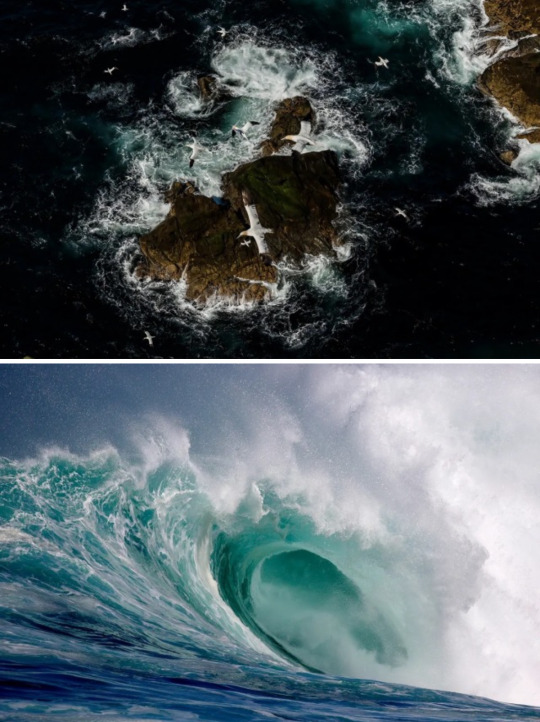
Top: Above Water Seascapes — 2nd Place! Northern gannets (Morus bassanus) soar above the dramatic cliffs of Scotland’s Hermaness National Nature Reserve, their sleek white bodies and black-tipped wings slicing through the Shetland winds. These seabirds, the largest in the North Atlantic, are renowned for their striking plunge-dives, reaching speeds up to 100 kph (60 mph) as they hunt for fish beneath the waves. The cliffs of Hermaness provide ideal nesting sites, with updrafts aiding their take-offs and landings. Each spring, thousands return to this rugged coastline, forming one of the UK’s most significant gannet colonies. It was a major challenge to take photos at the edge of these cliffs at almost 200 meters (650 feet) with the winds up to 30 kph (20 mph). Credit: Nur Tucker (UK 🇬🇧/ Türkiye 🇹🇷)
Bottom: Above Water Seascapes — Honorable Mention! A South Atlantic swell breaks on the Dungeons Reef off the Cape Peninsula, South Africa, shot while photographing a big-wave surf session in October 2017. It’s the crescendoing sounds of these breaking swells that always amazes me. Credit: Ken Findlay (South Africa 🇿🇦)
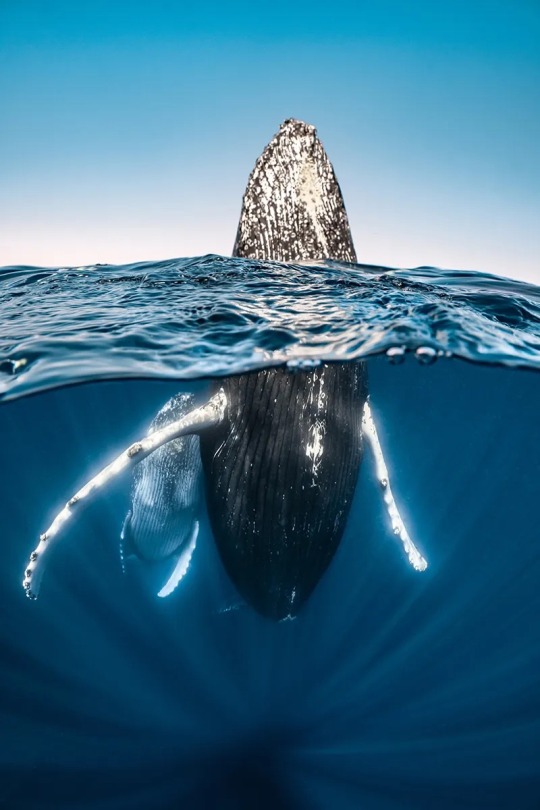
Wonder: Sustaining What Sustains Us — Honorable Mention! Humpback whales in their thousands migrate along the Ningaloo Reef in Western Australia every year on the way to and from their calving grounds. In four seasons of swimming with them on the reef here, this is the only encounter I’ve had like this one. This pair of huge adult whales repeatedly spy-hopped alongside us, seeking to interact with and investigate us, leaving me completely breathless. The female in the foreground was much more confident than the male behind and would constantly make close approaches, whilst the male hung back a little, still interested but shy. After more than 10 years working with wildlife in the water, this was one of the best experiences of my life. Credit: Ollie Clarke (UK 🇬🇧)
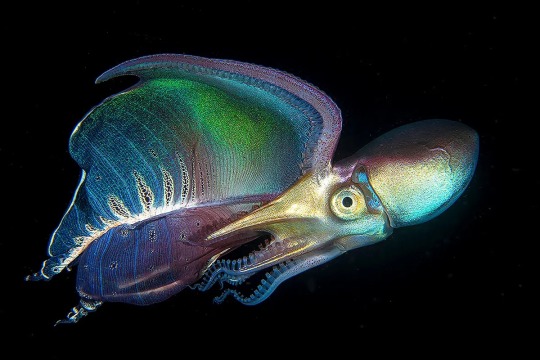
Big and Small Underwater Faces — 2nd Place! On one of my many blackwater dives in Anilao, in the Philippines, my guide and I spotted something moving erratically at a depth of around 20 meters (65 feet), about 10 to 15 centimeters in size. We quickly realized that it was a rare blanket octopus (Tremoctopus sp.). As we approached, it opened up its beautiful blanket, revealing its multicolored mantle. I managed to take a few shots before it went on its way. I felt truly privileged to have captured this fascinating deep-sea cephalopod. Among its many unique characteristics, this species exhibits some of the most extreme sexual size-dimorphism in nature, with females weighing up to 40,000 times more than males. Credit: Giacomo Marchione (Italy 🇮🇹)
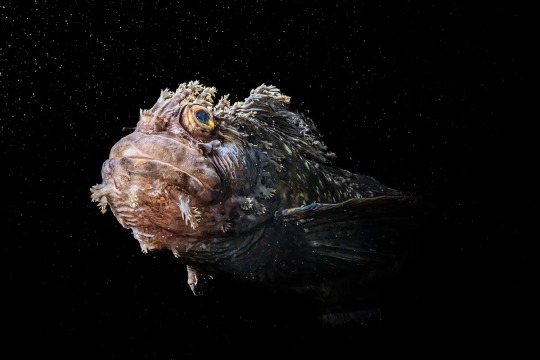
Big and Small Underwater Faces – Winner! This photo of a Japanese warbonnet (Chirolophis japonicus) was captured in the Sea of Japan, about 50 miles (80 kilometers) southwest of Vladivostok, Russia. I found the ornate fish at a depth of about 30 meters (100 feet), under the stern of a shipwreck. This species does not appear to be afraid of divers—on the contrary, it seems to enjoy the attention—and it even tried to sit on the dome port of my camera. Credit: Andrey Nosik (Russia 🇷🇺)

Wonder: Sustaining What Sustains Us — 2nd Place! A juvenile pinnate batfish (Platax pinnatus) captured with a slow shutter speed, a snooted light, and deliberate camera panning to create a sense of motion and drama. Juvenile pinnate batfish are known for their striking black bodies outlined in vibrant orange—a coloration they lose within just a few months as they mature. I encountered this restless subject in the tropical waters of Indonesia’s Lembeh Strait. Capturing this image took patience and persistence over two dives, as these active young fish constantly dart for cover in crevices, making the shot particularly challenging. Credit: Luis Arpa (Spain 🇪🇸)
—United Nations 🇺🇳, World Oceans Day, WWW.UNWorldOceansDay.Org
#United Nations 🇺🇳#World Ocean’s Day#Miscellaneous Photographs#Riveting Images#2025 UN World Oceans Day Photo Competition#Oceans: The Source of All Life#Nature’s Deep Connection#Popular Science Team#PopSci.Com#Environment#Animals#Whales 🐋 🐳#Fish 🐠🐡🐟#Sharks 🦈🦈🦈#Lakes#Antarctica 🇦🇶#Antarctic Peninsula#Rare Blanket Octopus 🐙
1 note
·
View note
Text
Sicktember 2024 Prompt-Based Resources to Help You Get Started! 💚

**Sicktember 2023 prompt-based resources can be found [Here]
Hangovers
What is a hangover [niaaa.nih.gov]
15 hangover horror stories [buzzfeed.com]
7 ways to cure your hangover [health.harvard.edu]
How to Write a Drunk Character [allwritealright.com]
Over Indulgence
Dealing with Food hangovers [health.usnews.com]
4 Ways to Stop Digestive Discomfort [michiganmedicine.org]
I Ate Too Much. Now What Do I Do? [osfhealthcare.org]
Is It Possible… Stomach Explode? [popsci.com]
Campus/Con Crud
Crushing the Campus Crud [hercampus.com]
So What is Con Crud [granitcon.com]
Coming Down With the Crud [bmhsc.org]
Rogue Organs
What Is Appendicitis? [hopkinsmedicine.org]
Gallbladder Removal [nhs.uk]
Tonsillectomy [mayoclinic.org]
Spleen Problems and Removal [nhs.uk]
Dizziness/Vertigo
Understanding Vertigo [on.bluecross.ca]
Types of Vertigo [acare.abbott.com]
Dizziness vs. Vertigo [cornerstonephsio.com]
Medieval Treatment
Medicine in the Middle Ages [ncbi.nlm.nih.gov]
6 Medieval Medical Practices [guavahealth.com]
Healing Power of Maggots/Leeches (Modern) [mountainview-hospital.com]
When Medicine was Humorous [merryfarmer.wordpress.com]
Mononucleosis
About Mono [cdc.gov]
Mono For Teens [kidshealth.org]
How to Test for Mono [mountsinai.org]
Sick People Food
What People Around the World Eat When Sick [businessinsider.com]
Sick Day Foods Across the Globe [nyubiteclub.com]
8 Best Foods to Eat When Feeling Sick [forbes.com]
Toxin/Poison
Poisons and Toxins [sciencelearn.org]
Poisoning. What The Doctors Do [thedoctorwillseeyounow.com]
Common HouseHold Poisons [cincinnatichildrens.org]
FAQs Carbon Monoxide Poisoning [cdc.gov]
Brain Fog/Spaced Out
What is Brain Fog [everydayhealth.com]
Understanding Brain Fog [henryford.com]
Causes of Zoning Out [verywellhealth.com]
Aches And Pains
What Causes Body Aches When Sick? [uclahealth.org]
5 Tips For Writing About Physical Pain [louiseharnbyproofreader.com]
Hypochondriac tendencies
Illness Anxiety Disorder [my.clevelandclinic.org]
Signs You May be a hypochondriac [centerforanxietydisorders.com]
10 Health Anxiety Myths [happiful.com]
How To Write Anxiety [writerscookbook.com]
Anaphylactic Response
What is Anaphylaxis [betterhealth.vic.gov.au]
Anaphylactic Shock: What You Need to Know [healthline.com]
Waiting Rooms
What happens in the emergency department [advocatehealth.com]
Triage and Emergency Assessment [ncbi.nlm.nih.gov]
Setting Description: Emergency Waiting Room [writershelpingwriters.net]
Summer Flu
Can You Get the Flu in the Summer? [verywellhealth.com]
Leisure Sickness [avogel.ca]
Catching a Cold When It’s Warm [newsinhealth.nih.gov]
Heart Condition/Cardiac Arrest
Types of Heart Attacks [www.healthline.com]
Common Heart Conditions [summahealth.org]
What Does a Heart Attack Feel Like? [health.clevelandclinic.org]
How to Describe a Heart Attack in a Story [writingtipsoasis.com]
Pulling a Ferris Bueller
Define Pulling a Ferris Bueller [urbandictionary.com]
Ferris Bueller’s Day Off Summary [gradesaver.com]
10 Things Ferris Bueller Taught Us [dailyedge.ie]
A Note From the Mods [Tumblr Post]
Sick While Traveling
Take Steps to Stay Healthy While Traveling [cdc.gov]
Motion Sickness [sciencefocus.com]
How to Remove Vomit From Car Interior [wikihow.com]
Sick on Vacation Tips [apartmenttherapy.com]
Hospital Bed
How to Write a Hospital Scene [writersdigest.com]
Hospital Bed Components & Safety [robsonforensic.com]
9 Way to Help When Someone is Hospitalized [upstate.edu]
First Aid Kit
Make a First Aid Kit [redcross.org]
Travelers First Aid Kit [hopkinsmedicine.org]
Health Plan and First Aid for College [uh.edu]
Flushed Cheeks
Causes of Facial Flushing [verywellhealth.com]
What Can Cause Flushed Skin? [medicalnewstoday.com]
Doctor's Note
Obtaining a Dr Note for Work [inhersight.com]
How to Get A Dr. Note for School [solvhealth.com]
#sicktember#sicktember 2024#resources and advice#links#prompt based links#hangovers#stomach ache#campus/con crud#cold and flu#rougue organ#dizziness/vertigo#medieval treatment#mononucleosis#sick people food#bland diet#toxin/poison#body aches#anaphylaxis#waiting room#summer flu#heart condition/heart attack#k on#yui hirasawa#sick fics#sick character#writing resources#sick fic tips
218 notes
·
View notes
Text
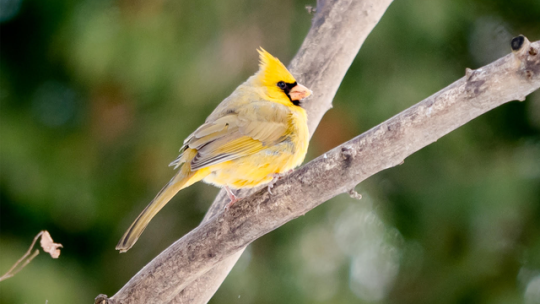
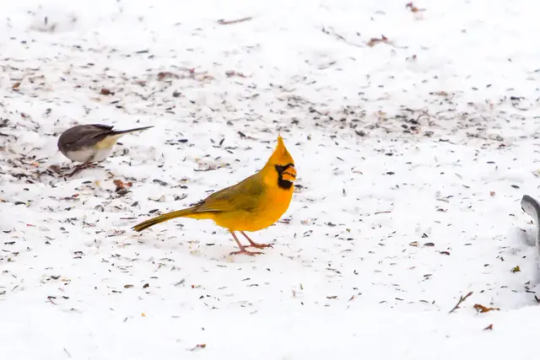
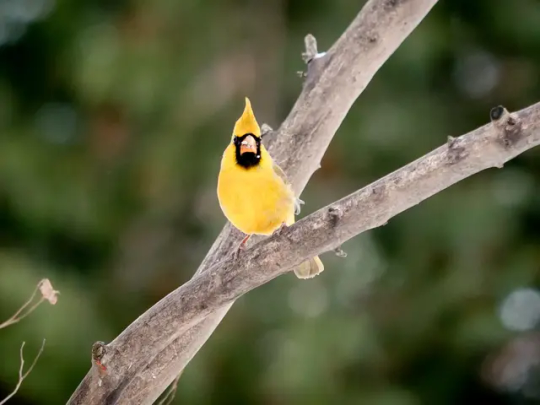
Just before Christmas, two backyard birders in Michigan were in for the ultimate surprise–a yellow Northern Cardinal. Arlene and John McDaniel spotted the incredibly rare bird in their backyard in Bath, Michigan near East Lansing. from Popular Science 1.9.25 popsci.com
6 notes
·
View notes
Note
The dye in Doritos can make mice transparent | Popular Science (popsci.com)
be careful! when enjoying your doritos, if u go see through we might not be able to find you
i absolutely adore that like a dozen people have sent me this. everyone really thinks of me.... ;-;
11 notes
·
View notes
Text
Geothermal Energy: Big Tech’s Bet Against AI’s Rising Energy Demands

Source: popsci.com
Category: News
Big Tech’s Clean Energy Dilemma
Silicon Valley’s push for sustainability is being challenged by the rapid rise in energy consumption driven by artificial intelligence. Tech giants like Google, Meta, Microsoft, and OpenAI have long championed Geothermal Energy, but the environmental cost of AI’s exponential growth is putting these ambitions under strain. According to Google’s 2024 Environmental Report, the company’s greenhouse gas emissions have surged by nearly 50% since 2019, largely due to the energy-intensive demands of AI.
The soaring emissions are casting doubt on Big Tech’s goals, such as Google’s target of achieving net-zero emissions by 2030. AI-powered services consume significantly more energy than standard operations, with generative AI systems using up to 33 times more electricity than traditional computing processes. A Cornell University study also found that each AI-powered query uses roughly ten times the energy of a conventional internet query. With AI quickly becoming the backbone of tech infrastructure, experts project that its energy consumption could account for 3.5% of global energy usage by 2030, a stark reality that has alarmed regulators and environmentalists alike.
Geothermal Energy as a Solution
To tackle the growing energy crisis, Big Tech is exploring alternative clean energy sources such as nuclear fusion, fission, and geothermal energy. Among these, geothermal energy has emerged as a promising candidate due to advancements in drilling technology inspired by the fracking industry. Companies like Meta and Alphabet are actively partnering with geothermal startups to power their energy-hungry data centers.
Geothermal energy, with its potential for virtually limitless clean power, is gaining traction, especially in resource-rich states like Texas. According to the Texas Geothermal Energy Alliance, the state’s abundance of geothermal resources and streamlined regulatory environment have made it a hub for new projects. Despite its potential, geothermal energy faces significant challenges. Developing geothermal resources requires substantial upfront investment, with over $700 million allocated to such projects since 2020—a relatively small figure given the scale of the AI-driven energy crisis.
Challenges in Scaling Geothermal
While geothermal energy is gaining attention, it faces stiff competition from the natural gas industry, which is experiencing a production boom. With robust support from the incoming U.S. presidential administration, natural gas is set to dominate the energy landscape, making it difficult for geothermal projects to compete on cost.
Analysts suggest that while geothermal energy offers long-term benefits, its development timeline and initial expenses have tempered enthusiasm among investors. “The energy transition is not just about finding clean energy sources but ensuring they are economically viable,” said Matt Welch of TxGEA.
As AI continues to fuel unprecedented energy demands, the pressure on Big Tech to innovate in the energy sector grows. Whether geothermal energy can rise to the challenge and secure its place in the clean energy future remains to be seen, but the urgency to address AI’s environmental impact is undeniable.
#GeothermalEnergy#RenewableEnergy#CleanEnergy#SustainableEnergy#GreenEnergy#EcoFriendly#ClimateAction
0 notes
Text
‘A needle in a haystack:’ How AI is helping uncover abandoned oil wells - popsci.com
The model was trained on hundreds of thousands of topographical maps spanning a century.
0 notes
Text
بعدما شكلت هوس أجيال من اللاعبين على مدى 40 عاماً، هُزمت لعبة الفيديو «تتريس» أخيراً على يد مراهق أمريكي، وهو إنجاز لم يكن يتحقق في السابق إلا عبر الذكاء الاصطناعي.أصبح ويليس غيبسون البالغ من العمر 13 عاماً، أول إنسان يصل إلى نهاية هذه اللعبة الكلاسيكية الرائعة من «نينتندو»، وفيها يتعين على اللاعب التوفيق بين الكتل التي تسقط بسرعة متزايدة، لتشكيل خطوط كاملة وجعلها تختفي.لعبة الأحجية هذه المسبّبة للإدمان والتي طورها مهندس سوفييتي ليس لها نهاية فعلية، فحين لا تتمكن الآلة من الاستمرار، تتجمد الشاشة فجأة.وهذا ما حدث للمراهق الملقب باسم «بلو سكوتي» عندما وصل إلى المستوى 157 بعد 38 دقيقة من المجهود.«يا إلهي».. هتف المراهق حين توقفت اللعبة، كما ظهر في مقطع فيديو على موقع «يوتيوب»، مضيفاً «لم أعد أشعر بأصابعي».وقال فينس كليمنتي، رئيس بطولة العالم للعبة «تتريس»، لصحيفة «نيويورك تايمز»: «لم يحصل هذا الأمر سابقاً من قبل إنسان» مضيفاً «إنه أمر اعتقد الجميع أنه مستحيل حتى سنوات قليلة خلت».لفترة طويلة، كان المستوى 29 يعتبر الحد الأقصى للعبة، عندما تصبح سريعة جداً لدرجة لا يعود بإمكان البشر التفاعل معها بسرعة كافية.وفي السنوات الماضية، تجاوز جيل جديد من اللاعبين حدود ما هو ممكن من خلال اعتماد تقنية «التدحرج» التي تغير طريقة استخدام وحدة التحكم NES لأنها تسمح باستخدام كلّ الأصابع بدلاً من مجرد واحد أو اثنين، ما يزيد إلى حد كبير من وتيرة الضغط.استخدم ويليس غيبسون المتحدر من أوكلاهوما، هذه العملية لتسجيل رقمه القياسي قبل أشهر قليلة من الذكرى الأربعين للعبة التي صدرت في يونيو / حزيران 1984. وهو إنجاز لقي ترحيباً واسعاً في مجتمع «اللاعبين»، وهنأت مايا روجرز، المديرة العامة للعبة «تتريس»، اللاعب الشاب في بيان نشر على موقع popsci.com. المصدر: صحيفة الخليج
0 notes
Text

THE SKYKNIGHT:
UKR’s Ministry of Defense reveals a new, indigenously produced quadcopter UCAV.
This locally produced multi-mission drone can conduct recon and strike operations against armor, vehicles and point targets. https://popsci.com/technology/ukraine-skyknight-drone/…
0 notes
Link
#vr#virtual reality#augmented reality#ar#june 2018#january 2018#popsci.com#popular science#Author: Billy Cadden#Cadden#4D Science Augmented Reality Kit#Augmented reality cube#4D Augmented Reality games#Virtuali-Tee#Star Wars: Jedi Challenges#Star Wars#Jedi#cube#games#gaming#game#toys#Curiscope#Lenovo#360-degree#Shifu Safari#Merge Cube#Spicebox Books
1 note
·
View note
Text
What Was Food Like Before The FDA? Formaldehyde, Brick Dust, Lead, And Borax Once Made Grocery Shopping A Minefield.
— By Lauren Leffer | May 1, 2025 | Popular Science

A Milkman Having His Float Inspected, Circa 1935. Credit: Photo By General Photographic Agency/Hulton Archive/Getty Images
We have a tendency to romanticize the past. Think about the food your great grandparents (or even their parents) ate in childhood and you might imagine farm fresh produce, pure milled grains, and pristine meat and dairy. But if they were living in the United States during the mid-to-late 19th century, that vision of food utopia wasn’t likely reality.
Before 1906, there were no federal food safety regulations in the US. Local grocers were a wild west of unlabeled additives, untested chemicals, and inedible fillers. In the gap between the industrialization of the food system during the mid-1800’s and those first laws dictating what could be sold as food, working class Americans spent decades eating “mostly crap,” says Deborah Blum, a Pulitzer-Prize winning science journalist. In her 2019 book, The Poison Squad, Blum details the origin story of the landmark Food and Drug Act.
As more folks left farm life behind and came to rely on manufactured food “an enormous amount of food fraud” emerged, Blum tells Popular Science. Nowadays, the overwhelming majority of people continue to purchase their food from grocery aisles, but the food we buy there is much less liable to make us sick. So, how did we get from that past to our current present? And, with regulatory agencies including the FDA facing enormous cuts, what might the future hold?
Ground Shells, Brick Dust, and Bones
European countries, including Britain, Germany, and France passed food safety regulations about 50 years before the US did. In classic American style, we eschewed top-down restrictions and allowed the free market, free rein. In lieu of federal regulation, there was a haphazard patchwork of state and local laws surrounding certain foods pre-1906. Massachusetts, for instance, passed “An Act Against Selling Unwholesome Provisions” in 1785. But unsafe practices consistently fell through the cracks and into consumers’ stomachs, says Blum. In some cases, food wasn’t food at all.
Pre-pasteurization, milk spoilage and bacterial growth was a major problem. Away from the farm, dairy had to travel farther and keep for longer if people in cities were going to buy it. So, the dairy section became a hotbed of questionable additives. Borax, which you may recognize as a general-purpose pesticide, was used as a milk and butter preservative. Formaldehyde (AKA embalming fluid) was also a common milk additive and antibacterial agent. In addition to preserving the milk, formaldehyde also reportedly had a slightly sweet flavor, which helped improve the taste of rot, Blum explains.

A cartoon titled ‘Poisoning by Food Adulteration’. In November 1858 a confectioner bought Plaster of Paris from a druggist to add to lozenges. Instead of Plaster of Paris, he was acidentaly sold arsenic and 20 people died out of the roughly 200 people poisoned. This case gave ammunition to those trying to get legislation against food adulteration through Parliament (Scholfield Act of 1859). Illustrated by John Leech (1817-1864) an English caricaturist and illustrator, and dated to the 19th century. Arsenic was also used to dye food. Credit: Universal History Archive/Universal Images Group via Getty Images. Universal History Archive
In cheese, lead compounds were added to boost its golden color. Plaster of Paris, gypsum, and other white, powdery fillers made their way into milk and flour for color and texture. Flour was often portioned out by the grocer in-store–with mixed results. “If you went to a very honest grocer, you might get real flour. If you didn’t you might get a mix,” she says.
Coffee and spices were particularly terrible offenders. Ground coffee was often about 80 to 90 percent adulterated in the mid-19th century, says Blum. It might be made up of ground bone, blackened with lead, or charred seeds and plant matter. Spices were frequently 100 percent adulterated. Or, in other words, entirely made up of something other than what they were sold as. Cinnamon was frequently brick dust. Ground pepper could have been ground shells or charred rope. “Probably a good half of these products had some adulteration, depending on what you were looking at and how much you were willing to pay,” she says. The wealthy were generally able to afford higher quality, authentic, uncontaminated products.
But for everyone else, the problem of food fraud was so prevalent that people developed a suspicion of ground coffee, Blum says. Consumers started opting for whole beans instead, wherever possible. Suddenly, there was a market for counterfeit whole coffee beans, made of pigeon beans and peas, or even wax and clay. “You can find flyers that went to grocers that said, ‘you can, multiply your profits with our super cheap dirt beans.’”
In her research, Blum found a record of a congressional hearing, where a food manufacturer described producing and selling a “strawberry jam” that was entirely red dye, corn syrup, and grass seed. His defense for the practice: “we have to be competitive in the market and other people are doing it too,” paraphrases Blum.
As all of the above was going on, people had little idea what they were consuming. “There was no labeling,” she notes. Though there were many cases of people falling ill. In an Indiana orphanage, multiple children died from formaldehyde poisoning. In New York state, an estimated 8,000 infants died from adulterated “swill milk” in a single year.
Pushing For Purity
Calls for change came from multiple fronts, including womens’ groups and the growing “pure food” movement of the late 1800s, says Blum. But one chemist and physician, Harvey Washington Wiley, proved particularly dedicated and ultimately influential.
Wiley began noting and publishing reports on food contaminants during his work at the USDA in the 1880s and ‘90s. His primary job was to develop alternatives to sugar cane, but he started studying and cataloging adulteration in butter, milk, and honey– and later spices and alcoholic beverages. That’s where much of our data on food adulteration at the time comes from, notes Blum. Soon, Wiley was releasing regular bulletins on food adulterants and advocating for national laws.
Many of his early attempts ended in failure. Congressional representatives received a lot of money from the food industry, and weren’t receptive to Wiley’s science-backed pleas for labels, transparency, and contamination regulations, says Blum. “He keeps pushing for it. The industry keeps shooting it down, and the political dog fight continues,” she says.
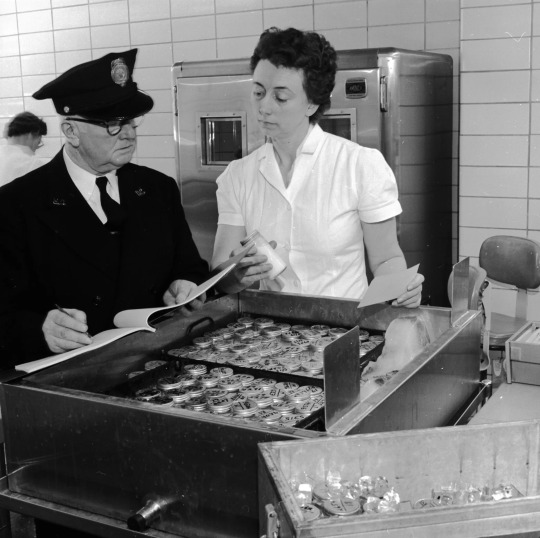
Hubert E Mills of the Department of Pasteurized Dairy Products and Dora Morris, technician for the Maryland and Virginia Milk Products Association, checking samples taken from a farm for purity. Circa 1955. Credit: Photo by Evans/Three Lions/Getty Images. Evans
But then, Wiley shifted tactics. He began conducting a series of experiments that he called the “hygienic table trials” with a group of USDA employees, later dubbed “the poison squad.” All of the dozen or so participants willingly and knowingly signed up to receive three freshly prepared meals, seven days a week, for six months from the newly created USDA test kitchen. Yet, along with their nourishing meals, a subset of the participants were also fed additives commonly found in adulterated food. “You could never have gotten this sort of study approved today,” says Blum. “He poisoned his co-workers.”
The group worked their way through borax, boric acid, salicylic acid, benzoic acid, sulfur dioxide, formaldehyde, copper sulfate, and saltpeter– among other things. Unsurprisingly, the squad was frequently sick and the experiment garnered a ton of publicity. “If you go to newspapers of the time, every single one had a story–’Americans are eating poison,’” Blum says.
The fervor, paired with the public outcry in response to Upton Sinclair’s book The Jungle, about Chicago’s meatpacking plants, led politicians to change their tune. In 1906, Congress passed both the Meat Inspection Act and the Food and Drug Act (colloquially known as “Wiley’s Law”). Later, the Food and Drug Act would be replaced by the Food, Drug, and Cosmetics act of 1938, which has been extensively revised and updated since. From these laws, the modern USDA– responsible for regulating meat and poultry products– and FDA, responsible for all other foods and pharmaceuticals, emerged.
The Future of Food
Since the start of federal food regulation, states have beefed up their policies and the food industry has adopted its own standards. Many companies have even signed on to efforts like the Global Food Safety Initiative, which involves third-party testing beyond what’s legally required. Plus, the mere existence of federal law means that people can sue when things go wrong. Litigation is a big driver of compliance and caution at the corporate level, says Blum.
Yet the FDA still plays a key role in oversight, research, and responding to emerging threats like bird flu in milk, says Brian Schaneberg, a chemist and director of the Institute for Food Safety and Health (IFSH) at Illinois Tech.At IFSH, academic researchers collaborate directly with industry and FDA scientists and the institute hosts multiple federal projects and labs. Research there includes work on improving infant formula safety, food contamination from packaging, pathogen prevention in food manufacturing and produce, investigating the causes of illness outbreaks, and Grade A milk validation. “We really touch a lot of areas,” Schaneberg tells Popular Science.
Recently, the Trump Administration slashed more than 3,500 FDA jobs, amid broader slap-dash federal cuts. Despite claims to the contrary, these layoffs included dozens of scientists who conduct quality control and proficiency testing on everything from infant formula to dairy products and pet foods. The cuts have temporarily left the Center for Processing Innovation at IFSH almost entirely unstaffed, Schaneberg notes. From 15 staff, they’re down to four. Other labs across the country were also impacted.
After public pushback, FDA leadership promised to reinstate scientists in key roles and re-open a handful of the shuttered labs last week. At Schaneberg’s institute, federal scientists have been told they’ll be reinstated. Though, he notes they haven’t received formal notices confirming their re-hiring. The long-term fate of FDA research and testing labs also remains uncertain as proposed major budget cuts and a massive reorganization looms. The currently proposed Trump Administration plan would shift most food testing to the states.
“I’m definitely concerned,” says Schaneberg. He doesn’t see any clear, immediate threat to consumers, but in the long-term– he is worried about the FDA’s ability to ensure food safety if the agency is equipped with fewer staff and resources. “I still think all the big companies are going to do the best thing they can because they don’t want to hurt their brands and they don’t want to impact people.” And many states might have the ability to fill gaps. Yet there’s always bad actors, new brands, new additives, and unknowns, he notes.
It may be much rarer than it once was, but the FDA still detects unsettling instances of food contamination. In 2023 and 2024, the agency investigated high lead and chromium levels in cinnamon applesauce pouches, marketed to children, notes Martin Bucknavage, a senior food safety extension specialist in the Department of Food Science at Penn State University. “There’s those types of things that pop up, and it’s like ‘who– who else is going to go through and do that?,’” he says. The FDA has expertise in the science and the supply chains that few other institutions do, Bucknavage says, along with the ability and authority to respond quickly.
With rapid changes and reorganization on the horizon, it’s hard to predict what the effect will be, he adds. “I think immediate-term, our food supply is going to be safe,” Bucknavage says. After all, FDA inspections are far less frequent than companies’ own safety tests and measures. But without the final layer of oversight, it’s possible something could be lost down the line, he says.
Blum, with all her knowledge of the treacherous food landscape of decades past, agrees. “I’m not sitting here saying catastrophe, because we don’t actually know,” she says. “But there’s nothing in what the [Trump Administration] is doing that you would look at and say, ‘oh this makes us safer.’”
1 note
·
View note
Text
Octopuses and cuttlefish distribute their brain cells throughout their squishy bodies; their arms contain up to three-fifths of their neurons and can carry out some actions on their own. If you disarm an octopus by cutting off some tentacles (please don’t), the disembodied limbs will continue to move for an hour or so. They apparently recognize themselves: They won’t grab each other the way they’d grip a piece of fish. An octopus also uses its brain-body to change its skin color and pattern, and shape-shift to look exactly like a patch of seaweed or some sand-speckled rocks. Research on these sensitive, short-lived creatures is skimpy, but this ability seems to be partly under conscious control: A hunting cuttlefish deploys a pulsating pattern to confuse prey, and a male can impersonate a female to avoid sexual competition. These inquisitive and extremely bendy beasts are more closely related to clams than to birds or monkeys, but they can do puzzles, problem-solve, think flexibly, and even play—suggesting that as smart as we are.
popsci.com
7 notes
·
View notes
Text
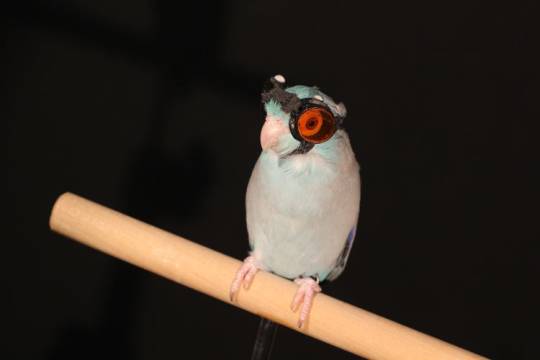
A little scientist, it is!
Image from popsci.com
2 notes
·
View notes
Text
A popsci.com trick nearly gave me carbon monocide poisioning
#low key freaking out lol#debating if i should go to the hospital to get checked out or not i really dont want to get covid
1 note
·
View note
Photo







Jacob Bigelow – Scientist of the Day
Jacob Bigelow, an American physician and botanist, was born Feb. 27, 1787.
read more...
#Jacob Bigelow#Mount Auburn cemetery#histsci#histSTM#19th century#history of science#Ashworth#Scientist of the Day
56 notes
·
View notes
Text
The midwest is in the midst of record-breaking, deadly floods

On the left, Offutt Air Force Base pictured by satellite on March 20, 2018. On the right, the same area seen on March 16, 2019. NASA Earth Observatory images by Joshua Stevens, using Landsat data from the U.S. Geological Survey
March 18, 2019
Historic flooding in the Central Plains, set off by last week’s “bomb cyclone,” devastated cities from Minnesota to Missouri this weekend, and will continue to inundate areas throughout the week.
As of Monday, 41 river locations, mostly in the Missouri River Valley, have set all-time records for water levels, according to Jonathan Erdman, a meteorologist for the Weather Company. Cities in eastern Nebraska, western Iowa, and southeastern South Dakota are among the hardest hit, with homes and roads wrecked and at least three deaths.
While the heavy rains from the last week’s winter storm were a “tipping point” for the floods, says Erdman, a number of factors led to the extreme event.
Read more ~ popsci.com

Flooding across the Midwest came a year after heavy rain deluged Indiana, pictured, Illinois, Michigan, Wisconsin and other Midwest states in February 2018 Read more ~ phys.org/
12 notes
·
View notes
